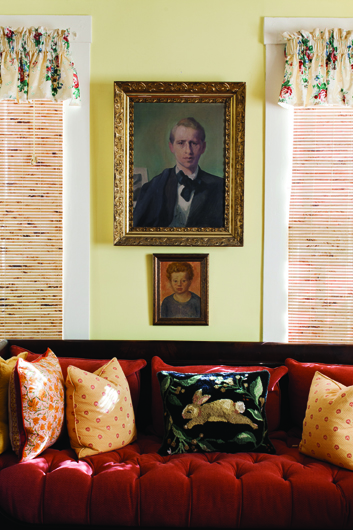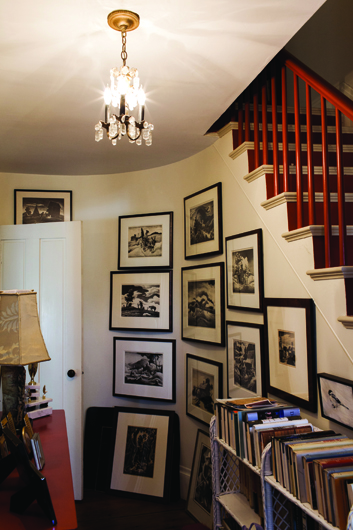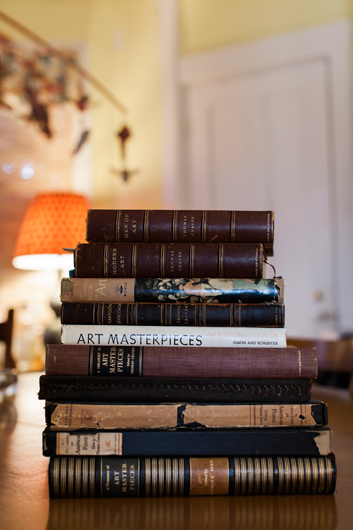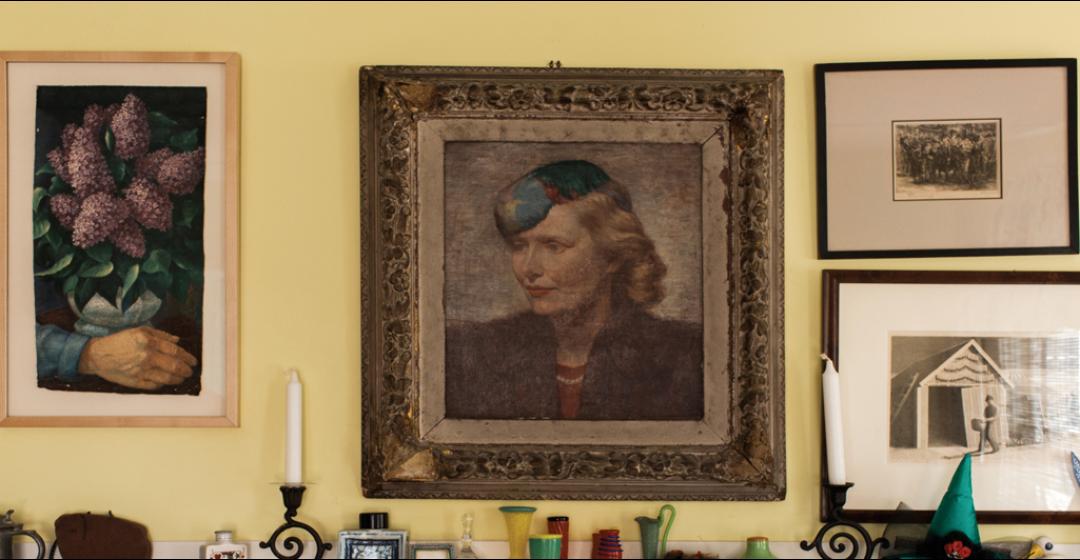In a manner of speaking, the estimable art critic Thomas Craven is still at home in his house in West Tisbury, keeping company with his old crowd. Thomas Hart Benton and Stan Murphy of Chilmark are there; also the Midwestern painters Reginald Marsh, John Steuart Curry, and Grant Wood; and the German Dadaist George Grosz, whom Craven famously pronounced the most distinguished artist of modern Germany. They are there in their art, the paintings, drawings, and homemade Christmas cards that hang in the front hall and parlor rooms like a private retrospective. The home brings back the excitement of the art world in the 1930s and ’40s and the new movement known as American regional expressionism, with its debt to Craven, who was its fiercest proponent, and its sources on the Vineyard. Craven, who died at eighty-one in 1969, quietly presides over the gathering in a half-dozen portraits, from the earnest young poet painted by Benton in 1912, to the seasoned and influential writer who retired full time to the Island in the late 1940s.

His daughter-in-law Carol Craven is the resident now, the storyteller and animator of the 1830 farmhouse. She is wistful that she never knew her father-in-law; by the time she met and married his son, Richard, and moved to the Island in the 1970s, Thomas Craven was dead. (Richard Craven died in 2001.) But with a background in theater and art, she was a natural curator for the family collection. For fifteen summers she exhibited American expressionism with other modernists at her Carol Craven Gallery, where she developed a passion for Island art and became a specialist in the work of Benton. Her bookshelves overflow with heavy volumes about Thomas Craven’s era and his colleagues. Not to mention Craven’s own work – a dozen books that include the now classic Men of Art and Modern Art: The Men, the Movements, the Meaning, the bestselling A Treasury of Art Masterpieces: From the Renaissance to the Present Day, and the scores of critical essays and articles that built his reputation as a “no holds barred” critic. Casually, she has added a spritely self-portrait that she painted as a girl to the family gallery on the walls, which includes a painting of Craven’s wife in a multicolored feathered hat and several Benton sketches of Richard as a young boy with a mop of curls.
To later generations of art lovers, Craven is a provocative and complicated figure, as well known as the sidekick of the famous and flamboyant Benton as he was as the conservative and controversial critic and author who promoted a new school of American art. The relationship began with the seedy apartments and hand-to-mouth lives they shared in New York for a decade before they had wives, and continued through the struggles of rising careers. Starting around 1920, it included the joys of rustic summers at the Barn House in Chilmark, amid a crowd of radical intellectuals there that included Eugene Debs and Norman Thomas, Roger Baldwin, Felix Frankfurter, Walter Lippmann, Van Wyck Brooks, and Bernard DeVoto. Through it all, Craven and Benton were loyal and tender friends. Both were Midwestern Democrats with distinguished fathers who had frowned on their desire to paint, and both had an innate love of traveling the back roads of America, which fed their aesthetics and feelings about the need for nativist art. But they were also a pair of opposites. Craven was shy, frail, scholarly, and neat, while Benton was tough, robust, and scrappy, which perhaps was their bond.

Following Craven’s career effectively documents and mirrors significant stages of Benton’s and vice versa. In the early experimental days, Craven was Benton’s frequent model – Benton painted him at his typewriter at the time of his first job as a critic for the prestigious Dial magazine and put him in his 1922 group portrait People of Chilmark. Craven, for his part, returned the compliment in his writing. Even before he reviewed Benton’s first successful gallery shows in New York or his first murals or promoted his ideas about form and rhythm in a full chapter in Men of Art, he was slipping references to Benton into reviews praising Cézanne or Seurat in the mid-1920s. That was before he changed directions as a critic and attacked French modernism and Bohemianism as a scourge in France – “Picasso’s abstract values” and the “hallucinations of the surrealists” – and to talk about the importance of an art that began at home and caught the true spirit and shape of the American experience.
Craven had a fine mind and a classical education, and he wrote fluently about art, about which he thought deeply. His sensitivity to the artist’s mind was evident in his young novel Paint, which came out of the year he spent in Paris learning to paint. He had liked France, as had Benton, who returned home wearing a beret, but he also came to see French modern art as decadent, indulgent, and superficial, its sophisticated styles inappropriate for the still young American culture. Craven championed representation, the importance of form over method, and what was called “environmental” art, referring to the newly popular idea that a particular geography like Kansas or New York City or the Vineyard shaped the lives and character of the people who dwelled in it. That message could be read in Benton’s People of Chilmark or his paintings of farm and beach scenes on the Vineyard, even in the shape of the waves or clouds in the background, which all described the local experience. Craven, always Benton’s interpreter and spokesman, ultimately put Benton in a class by himself – “an American phenomenon, compared to the makers of amorphous patterns.”
Craven’s voice was strong and confident, but also famously caustic and chauvinistic when directed at abstract painting or the European modernists he dismissed as mere Bohemians. It is startling now to read his derisive indictment of Modigliani as “a gifted wastrel” or his rant against Picasso as a master strategist whose “art is perfect because it offers nothing” or his pronouncement that the art of the modern school of Paris “is the last gasp of a dying culture.” This was a time of painful transition in America, post–Armory Show and post–World War I and mid-Depression, and in promoting American regionalism and the painters of classic “American scenes,” Craven and others in the movement were partly expressing their disillusion with the changing nature of society, their fears about the emerging modern way and a dogged old-fashioned patriotism.

“We can no longer turn away from the significance of the subject matter of art,” Craven wrote in his sweeping survey Modern Art in 1934. Examining art as a creative act and a means of communication, he appraised the new work in Europe and America, and then issued his fervent appeal for an art that was a true reflection of the American spirit. American artists, he said, should “remain at home in a familiar background, to enter emotionally into strong native tendencies, to have done with alien cultural fetishes.”
That same year, Benton appeared on the cover of Time magazine, the first American artist to have that honor. Craven, his first-string supporter, had already been reviewed in the same magazine as “the man whom the entire U.S. art world listens to.” His Modern Art was popular with the public as well as essential reading in art schools for decades. In the next years, Craven wrote and edited other big books – anthologies of great art, American prints, artists and their models, a pioneering volume of American humorous cartoons called Cartoon Cavalcade. They were the first so-called coffee-table books, which gave the subject of art a significant new venue.
By the 1940s, therefore, Craven’s reputation as an important and wide-ranging art critic was secure, and his anger toward French modernists seems to have diminished, and, in the case of Picasso, even dissipated. He continued to proclaim Benton’s eminence among American painters and to come to his defense in the wrangles with critics. But by the late ’40s, with America refocused on a bright new future, and consumerism in full swing, the fire behind American regionalism cooled, its subject matter threatened by the changing landscape, its relevance challenged by the excitement about abstract expressionism. Benton was back living and painting in Missouri by then; Marsh and Wood had died. Craven moved to the Vineyard full time in 1949.
Craven and Benton kept in touch by letter, and they met during the summers on the Island. There were remnants of their old crowd of left-wing intellectuals around – Roger Baldwin, the cartoonist Denny Wortman, Alfred Eisenstaedt, Max Eastman, along with younger and sympathetic artists like Stan Murphy. They saw one another in the way of old friends: Craven gave Wortman advice on his own book of cartoons; Wortman and Benton painted one another; on social evenings, Benton might play the harmonica. Despite the passage of years and the signs of new times – electricity, tractors, more paved roads – the Island still had its simple ways, its folk ethos and the almost primeval landscape that made it a place unto itself. Craven liked to say that during their early years on the Vineyard, he had watched Benton becoming “more and more American,” which was another way of describing how Benton found his subject. The Island was Benton’s America then, and Craven’s, too, the land where they lived the experience that Benton was painting in his scenes of Menemsha fishermen, farmers in their fields, and the drama of hurricanes.




 1 comment
1 comment
Comments (1)